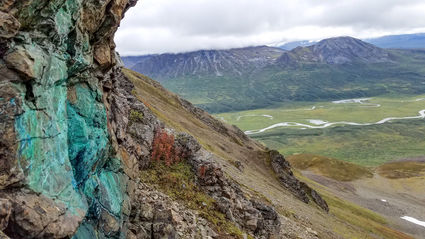Final 2018 PolarX assays; first look at 2019
North of 60 Mining News – February 8, 2019
Last updated 9/25/2020 at 1:59pm

Peter Taylor, Millrock Exploration Corp.
Copper stained outcrop at the Mars prospect, an area of the Alaska Range property where geochemical and geophysical evidence suggest the presence of a buried porphyry deposit.
PolarX Ltd. Jan. 29 reported that the final assays from the 2018 drill program at its Alaska Range project continues to tap copper-gold-silver mineralization below the resource boundaries of the Zackly skarn deposit.
Zackly hosts 3.4 million metric tons of inferred resource averaging 1.2 percent (90.4 million pounds) copper, 2 grams per metric ton (213,000 oz) gold and 14 g/t (1.5 million oz) silv...
For access to this article please
sign in or
subscribe.







Reader Comments(0)